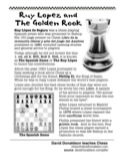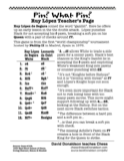Ruy Lopez de Segura

His 150-page primer on Chess, Libro de la invencion liberal y arte del juego del Axedrez, published in 1561, includes opening studies and general advice to players.
Although he did not invent the line:
1. e4, e5 2. Nf3, Nc6 3. Bb5, it is known today as The Spanish Game or The Ruy Lopez to honor his contributions. Lopez coined the word gambit.
About the year 1560 Lopez journeyed to Italy seeking a Chess book as a Christmas gift for his friend and patron, Phillip II, the King of Spain.
In Italy Lopez defeated the world's best players. Lopez also decided the best chess books of that day were not good enough for his King. So he wrote his own Libro. A sample of his advice to players:
"Sit across from your opponent so that the sun shines in his eyes" and "Make sure your opponent has had a full meal to make them sleepy".
After Lopez returned to Madrid Phillip hosted a tournament in 1575 where Lopez claimed the first unofficial world title.
Phillip presented his friend with a golden rook. And in the end, Ruy Lopez the chess player earned a promotion to real-life Bishop in the Catholic church.
Pin? What Pin?
An early lesson in double-attack. Lopez punishes Black for not accepting his f-pawn, breaking a soft pin on his Queen with a pair of checks around f7 (the Achilles Square).
This game is from the first 'world championship' tournament hosted by Phillip II in Madrid, Spain in 1575.
Notes
a) 2. ...d6 allows White to trade a side pawn for a center pawn. Black's best chances in the King's Gambit lie in accepting the f-pawn and exploiting White's weakened King-side pawns or counter-punching with d5.
b) It's not "Knights before Bishops" but it is "Develop with a threat" at f7 and Lopez's Knight hops out soon enough.
c) It's even more important for Black not to risk losing time with too many pawn moves. This move might support following up with 4...d5, kicking at the Bishop.
But on the next move Black switches tactics.
d) The difference between a hard pin and a soft pin is...
e) ...is that you can break a soft pin with check.
f) The missing Achilles Pawn on f7 creates a hole in front of Black's King for the White Queen to infiltrate.
Nutshells & Links

Image From ChessGames.com
student handout version
of this lesson:

This game in interactive pgn form.
This lesson in printer-friendly pdf form.
White
e4
f4
Bc4 b
Black
e5
d6 a









